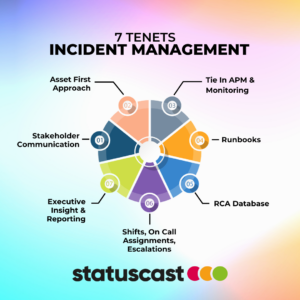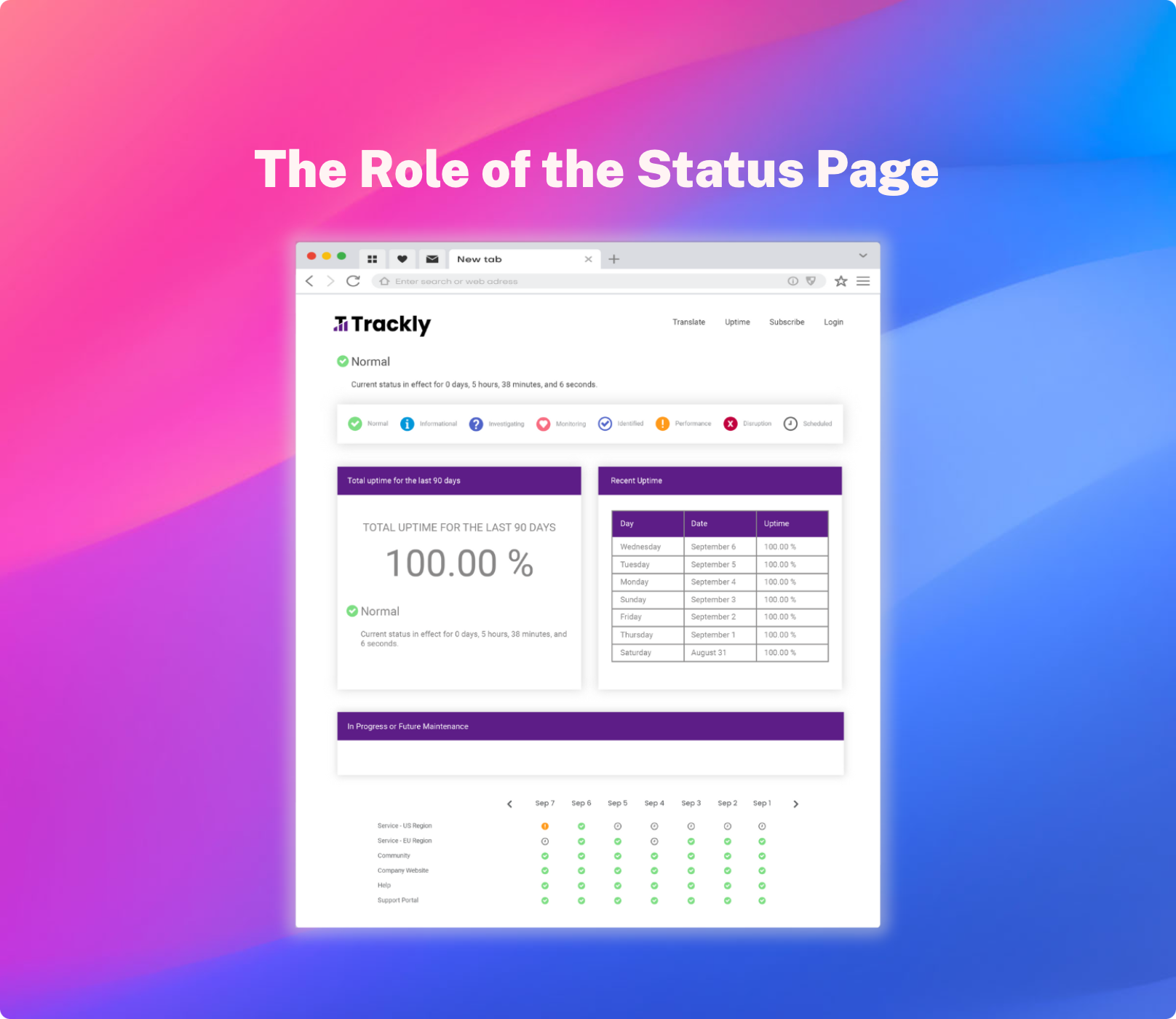In recent years, IT departments have faced the challenge of adapting to an evolving landscape of demands. While the primary focus of traditional incident management solutions has been to reduce downtime, it's become clear that just reducing the amount of downtime isn’t sufficient. To truly mitigate the total impact of downtime, there must be a focus on reducing the damage and costs that accumulate while you are down. Downtime cannot be entirely avoided, so when it happens, ensure that it is not debilitating for your entire organization. One of the greatest such costs of downtime turns out to be lost employee productivity. If IT doesn’t have the tools to adequately prepare their organization for the chaos of outages, and employees are left in the dark with no recourse, unable to perform their normal tasks, then the cost of every minute of downtime skyrockets. Effective Incident Management in 2024 is not just about reducing the amount of downtime, but reducing the damage that occurs while you are down.
Given the ubiquity of remote work, effective incident communication is more important than ever. A robust platform providing automated incident response and communication has become mission critical in supporting a distributed workforce. Keeping teams optimally informed and adequately prepared is necessary to mitigate an overflow of support requests and keep employees on task when outages occur. Businesses thrive during outages when they prioritize incident communication, to keep employees informed when disruptions affect their operations, and with ITSM automation, which saves IT from anything not directly related to rapidly resolving the incident.
Enterprises are accustomed to how severe hourly downtime costs can be. ITIC reports that over 90% of mid to large sized enterprises average downtime costs of over $300,000 per hour, with 44% reporting costs exceeding $1,000,000 per hour. However, the second order effects of outages have become more apparent to IT departments in recent years. Carbonite found that for 57% of IT departments, incidents often require 100% manpower and other resources for their duration, pulling teams away from other critical functions. This led 46% of organizations to report that loss of productivity was the biggest cost they faced in the wake of an incident.
A New Approach
To address this challenge, a new paradigm of IT incident management has emerged that puts the spotlight on reducing lost productivity, ensuring that not only are hours of downtime reduced, but the cost per hour down is reduced. This approach is centered on the idea that by keeping employees informed of the status, dependencies and root cause of outages, IT teams can protect organizational integrity and minimize the disruption caused by system failures. Enterprise IT departments have been looking to StatusCast to reinforce their incident response because of our unique approach to reducing downtime costs. StatusCast keeps employees updated with the status of affected services, with maximum depth and specificity of reporting, in order to efficiently resolve downtime while minimizing downtime cost.
One of the key features of our incident management solution is its ability to send targeted, personalized notifications to employees based on their role and the components/services they depend on. This ensures that employees only receive the information that is most relevant to them, helping to reduce noise and avoid information overload. Additionally, StatusCast empowers IT teams to save valuable time on incident notifications and updates by automating the process with AI-Powered Smart Incident Messaging, which crafts notifications with specific knowledge of the incident at hand and leverages your communication style from past messaging. These notifications are then distributed across multiple-channels, including Slack, Teams, Email, SMS and via push notifications; ensuring that employees are kept in the loop whenever disruptions affect services they depend on.
Leaning into ITSM automation is a key aspect of StatusCast's incident management approach. Whether it’s automatically crafting incident notifications, or managing complex integrations with Observability and APM tools, StatusCast ensures that IT teams are freed up to focus all their attention on solely expediting incident resolution.
StatusCast's unique approach marks the beginning of a new frontier in the world of Incident Management. Given the increasing reliance on remote work, it has only become more important for off-site IT teams to have a robust, automated incident solution. By prioritizing incident communication and leveraging automation, IT teams can keep employees optimally informed and maximally productive during outages, helping to effectively reduce the costs of downtime.
Discover How Our Incident Management Can Help Your Business Thrive
Book a Demo or Start Your Free Trial Today

The 7 Core Tenets of Effective Incident Management
Stakeholder Communication
Effective stakeholder communication is pivotal in our approach to incident management. When incidents arise, it's not only the IT team that faces a productivity slump; proactive communication is key to keeping the entire workforce active and engaged. Consider this analogous to avoiding a traffic jam upon receiving timely updates - it's about steering clear of disruptions and maintaining workflow continuity.
Asset First Approach
Our 'Asset First' approach marks a departure from traditional ITSM models. Rather than just focusing on incidents, we emphasize the importance of service components. This approach provides a clearer picture of how incidents affect the organization as a whole, enabling end-users to better understand and adapt to these disruptions.
Tie Into All Your APM and Monitoring
Integration with application monitoring systems is also a cornerstone of our strategy. In large enterprises, the multitude of systems, often operating in silos, can create a cacophony of alerts and notifications. Our solution centralizes these communications, filtering out irrelevant noise and focusing on what's truly actionable.
Runbooks
Runbooks are another essential element. While each incident might be unique, the underlying processes often aren't. Our ITSM system allows the creation of content templates, administrative tasks, and incident workflows. All of these assist IT professionals, easing their burden and streamlining the incident management process.
RCA Database
Extensive RCA (Root Cause Analysis) reporting and functionality is vital for truly proactive incident management. Instead of treating RCA as a mere follow-up to incidents, we categorize and report on them. This enables trend analysis and deeper insights, such as comparing hardware failures against third-party service outages over time, offering valuable data for strategic planning.
Shifts, On-call Assignments, Escalations
The complexity of IT departments, with their varied teams, shifts, and managerial structures, requires a flexible ITSM solution. Our system is designed to accommodate different team structures and responsibilities, ensuring efficient management of shifts, on-call assignments, and escalations. This structure further reduces informational noise and enhances focus on critical issues.
Executive Insight and Reporting
Incident Management reporting is an area where many ITSM solutions fall short. Our solution goes beyond basic incident reporting, offering comprehensive analytics on incidents, components, subscribers, SLAs, and more. This level of reporting provides valuable insights for stakeholders, enabling informed decision-making and strategic planning.
Wrapping Up - Empower Your Organization to Conquer IT Incidents
The essence of effective incident management lies in recognizing that your sole focus cannot simply be on reducing the amount of downtime, but in reducing the cost and damage while you are down. This holistic approach ensures that when inevitable disruptions occur, their toll on the organization's productivity and resources is significantly minimized.
At the heart of this refined strategy is the understanding that minimizing lost resources and productivity is the proper objective function for any organization striving for a tangible reduction in downtime costs. StatusCast embodies this philosophy, offering a suite of features designed to not just lessen downtime but also to alleviate its consequences. Through targeted communication, comprehensive incident management, robust status pages and strategic integrations, we provide a robust framework that supports continuous productivity, even in the face of IT challenges.
In embracing this comprehensive approach, organizations can navigate the complexities of modern IT environments more effectively, ensuring resilience, maintaining operational integrity, and ultimately, safeguarding their bottom line against the unpredictable nature of IT incidents.






